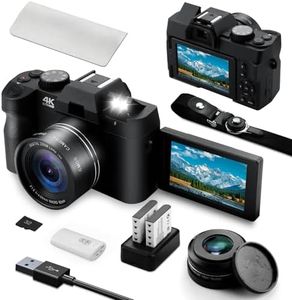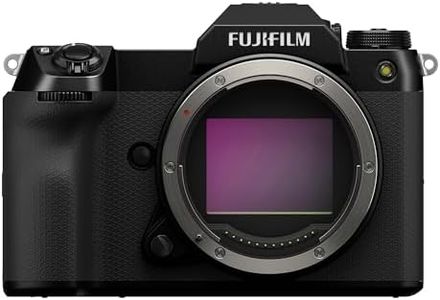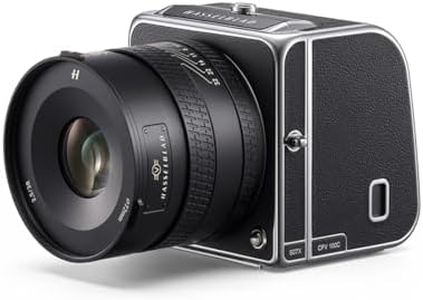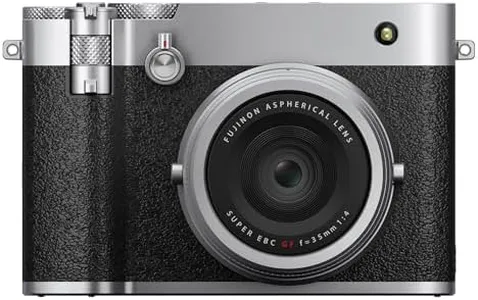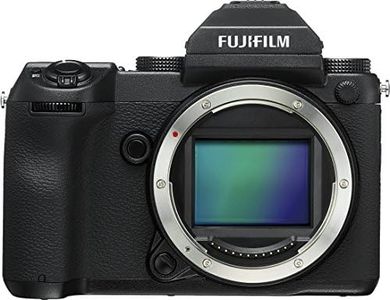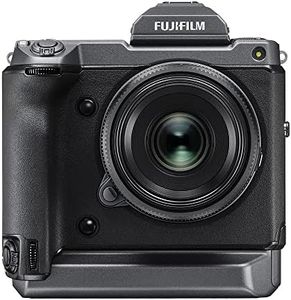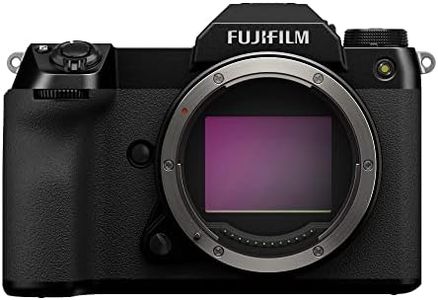8 Best Medium Format Cameras 2025 in the United States
Our technology thoroughly searches through the online shopping world, reviewing hundreds of sites. We then process and analyze this information, updating in real-time to bring you the latest top-rated products. This way, you always get the best and most current options available.

Our Top Picks
Winner
Fujifilm GFX100S II Body Mirrorless Medium Format Camera Body
Most important from
14 reviews
The Fujifilm GFX100S II is a robust medium format camera that stands out with its impressive 102-megapixel resolution, making it ideal for high-detail photography such as landscape and studio work. The newly developed sensor and X-Processor 5 ensure top-notch performance, including fast burst rates and 4K video recording capabilities. The camera's in-body image stabilization (IBIS) offers up to 8.0 stops of stabilization, which is beneficial for handheld shooting, reducing blur even in low light conditions.
Additionally, the face/eye and subject detection autofocus modes, assisted by AI, enhance the camera's usability for portrait and action photography by providing precise focus tracking. The ergonomic design, weighing under 2 pounds, makes it relatively light and portable compared to other medium format cameras, which adds to its versatility for various shooting conditions. Connectivity options like Bluetooth, Wi-Fi, and HDMI, as well as compatibility with a range of high-quality Fujifilm G mount lenses, enhance the workflow for both amateurs and professionals.
However, there are some drawbacks. The camera lacks an in-built flash, which might be an inconvenience for some users who rely on flash photography. The continuous shooting speed of 8 fps, while decent, may not be fast enough for capturing very high-speed subjects. The high price point and advanced features also suggest that this camera is best suited for serious photographers who need high resolution and dynamic range, rather than casual hobbyists. The Fujifilm GFX100S II offers outstanding image quality and professional features that will appeal to photographers looking for top-tier medium format performance.
Most important from
14 reviews
Hasselblad Hasselblad 907X & CFV 100C Medium Format Mirrorless Camera
The Hasselblad 907X & CFV 100C is a high-end medium format mirrorless camera that excels in image quality thanks to its enormous 100MP BSI CMOS sensor. This sensor size is larger than typical full-frame cameras, allowing for incredible detail and lifelike color, which is perfect for photographers needing sharp, professional-grade photos. The camera offers up to 15 stops of dynamic range, meaning it captures a wide range of light and shadow details, helping your images avoid harsh highlights or deep shadows that lose information. Lens flexibility is a major plus here: it supports Hasselblad's XCD lenses and can adapt to several vintage lens systems (HC/HCD, XPan, V System), giving you many creative options.
Autofocus is reliable with 205 phase detection points, suitable for precise focusing, although it might not be as fast or advanced as some high-end autofocus systems found in other cameras. The 3.2-inch tilting touchscreen makes navigating menus and reviewing images straightforward, even if you're new to medium format shooting. In terms of build, the camera's solid machined aluminum body feels durable yet remains relatively lightweight for its class, but it isn't weather-sealed, so extra care is needed in tough conditions. Connectivity is fairly basic, with a single USB-C port supporting image transfer and charging, but no built-in Wi-Fi or Bluetooth, which might slow down workflow for some users.
The camera does not support video recording, focusing solely on still photography. With a fast shutter speed up to 1/4000s and a native 3:2 aspect ratio, it suits a variety of shooting styles but is best for photographers who prioritize image quality over speed or video features. This camera is tailored for serious enthusiasts and professionals seeking top-tier still images and a classic medium format experience with modern usability, though it may be less suitable for casual shooters or those who require quick sharing and video capabilities.
Fujifilm GFX100RF Medium Format Camera - Silver
Most important from
8 reviews
The Fujifilm GFX100RF is a medium-format camera known for its compact, rangefinder-style design that offers a classic and comfortable handling experience. It boasts an impressive 102-megapixel CMOS sensor, providing extremely detailed and high-quality images, ideal for large prints or cropping without losing clarity. The camera features a fixed 35mm wide-angle lens with a digital teleconverter for flexible framing options, though it does not support lens swapping, which may limit creative options for users who prefer different focal lengths.
The autofocus system is hybrid with one autofocus point, which might not be optimal for fast-moving subjects or complex focusing scenarios. While it lacks in-body image stabilization, it offers digital stabilization to help reduce some handheld blur. The build quality is solid and designed to be portable, weighing approximately 735 grams, making it lighter than many other medium-format cameras. Connectivity options include built-in Bluetooth, Wi-Fi, and HDMI output, facilitating easy image transfer and connection to external devices. The 3.15-inch LCD screen allows for convenient composing and reviewing of shots, and the new aspect ratio dial enables quick switching between different image formats.
Additional features such as 20 film simulation modes provide creative in-camera effects that appeal to photographers who enjoy classic film aesthetics. The battery life lasts about 90 minutes, so bringing spare batteries is recommended for extended shooting sessions. The camera does not include a built-in flash or audio recording capabilities, which may be a consideration for users interested in video recording. This camera is well-suited for photographers prioritizing image quality and portability in a medium-format system, especially those focused on still photography and who appreciate a fixed lens with excellent optical performance. Users requiring versatile autofocus, interchangeable lenses, or advanced video features may need to consider other options.
Most important from
8 reviews
Buying Guide for the Best Medium Format Cameras
Choosing the right medium-format camera can be a rewarding experience, especially if you are looking to take your photography to the next level. Medium-format cameras are known for their superior image quality, larger sensors, and exceptional detail. However, selecting the right one involves understanding various specifications and how they align with your photography needs. Here’s a guide to help you navigate through the key specs and make an informed decision.FAQ
Most Popular Categories Right Now
